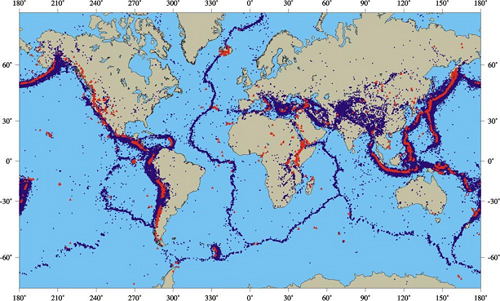If you want to find a plate boundary, follow the earthquakes. Plates are internally rigid and move about the Earth’s surface without deforming very much, so most of the world’s tectonic activity occurs at the boundaries where different plates interact with each other.

The rigidity of a plate’s interior means that if you know the speed and direction that the crust is moving at one point on a plate, you can calculate its motion at every point, and for two plates you can calculate the direction and magnitude of relative plate motions at any point on their shared boundary. This allows you to predict the broad style of deformation before you even look, because you already know whether the plates are moving apart, pushing together or sliding past each other. However, the details of how those relative motions are being accommodated at the boundary is not so easy to predict. Mid-ocean ridges, for example, consist of spreading segments separated by transform segments; two entirely different types of deformation accommodating exactly the same plate motions.

Things get even more complicated in continental crust, where a plate boundary is often not a discrete line you can stand astride like the meridian line in Greenwich, but is instead spread across many faults, across an area tens or even hundreds of kilometres across. The seismicity map above clearly shows this happening at the boundary between the Indian and Eurasian plates – earthquakes stretch considerably further north than the Himalayas, and even the Tibetan plateau. This distributed deformation opens up even more tectonic possibilities for accommodating relative plate motions. The figure below illustrates three possible arrangements in a convergent plate boundary zone: everything can be accommodated on one big thrust, but you might also get partioning of the oblique component of motion onto strike slip faults behind the main thrust, or even some of the motion being taken up by vertical-axis rotation of fault bounded blocks. Large scale plate motions might provide the boundary conditions of motion across a tectonic boundary, but there are clearly other factors that control its expression. I think there’s still a lot that we don’t understand about plate tectonics on the small scale.

I do have a hunch, though, that one of the reasons that deformation in continental crust can be so complicated is that it is usually quite old, and has probably been deformed several times before in its long history. The scars of these past rifts and orogenies have been inherited in the form of old, inactive faults; pre-existing weaknesses that can be exploited in new episodes of deformation, because it is often mechanically easier to reactivate old fractures than rupture entirely new ones. However, because they are probably not optimally arranged to cope with the current plate motions, weird and wonderful combinations of reactivated faults from different episodes can be co-opted together, with new structures, or bulk rotation of crust between faults, accounting for any left over deformation. Just to make things even more interesting, these arrangements might have changed significantly as plate motions have evolved over time; different structures could have been active in the past, or the same faults might have been accommodating motion in completely different ways. Thus, trying to fully understand deformation in plate boundary zones is often a lot more complicated than it looks. Knowing the general rheological properties of the crust is important, but the unique tectonic history of every part of the world gives each area its own distinctive tectonic flavour, and fully understanding the patterns of faulting today in places like New Zealand may depend as much on understanding the past geological history of the region as it does on knowing current plate motions. Plenty to go hmmmm about, then.



Comments (3)
Links (1)-
Pingback: Friday Focal Mechanisms: Haiti, revisited | Highly Allochthonous